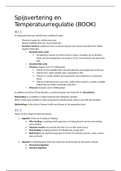Summary
Summary CH40 Digestive and Temperature Regulation
- Course
- Institution
- Book
Summary of the topic of digestion and temperature regulation from Campbell Biology a Global Approach, 11th edition. This summary includes notes of accompanying MasteringBiology assignments, lectures and any lectures. Summary of the topic of digestion and temperature regulation from Campbell Biolog...
[Show more]




